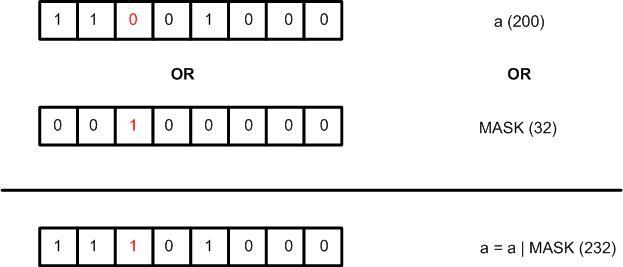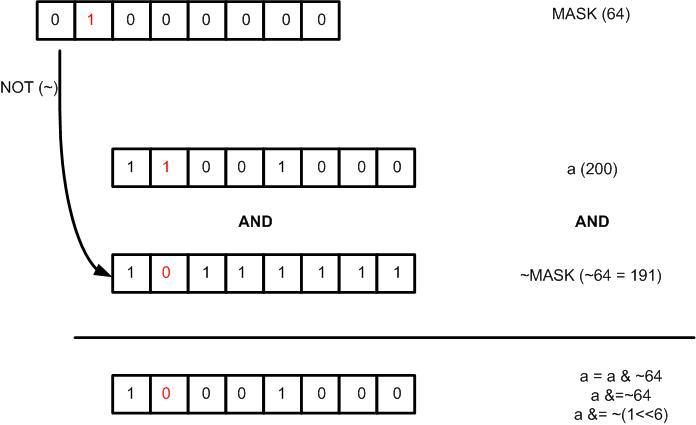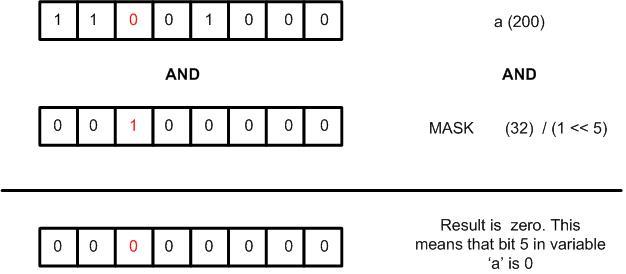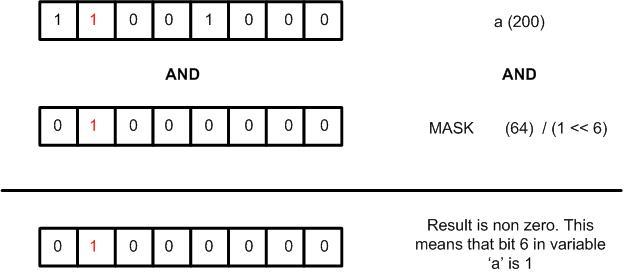This article covers Read Modify Write (RMW) operations. These operations allow the programmer to manipulate one or more bits of interest within a variable (or register), without affecting the state of the rest of the bits in that variable (or register). In order to understand RMW operations, the reader must have a solid foundation in bit manipulation. Bit manipulation basics were covered in the Bit Manipulation in C Part 1 – Bit Manipulation basics blog entry.
There are four main RMW operations:
- Setting one or more bits in a register.
- Clearing one or more bits in a register.
- Toggling one or more bits in a register.
- Reading the value of a particular bit within a register.
For the rest of this blog entry, variables and / or registers will be referred to as registers for brevity. Both refer to locations in memory where data is stored. The term register is typically used when referencing memory locations capable of directly affecting hardware operation of either the CPU or a hardware peripheral.
These types of operations are often referred to as Read-Modify-Write, because they consist of:
- Reading the state of the register,
- Modifying the state of that register by performing a bitwise logical operation on the value read from the register, with a bit mask of some kind intending to modify one or more (particular) bits within the register , and finally,
- Writing back the result into the same register.
Only the bits of interest are modified by an RMW operation. The state of the bits that are not of interest within the register never change.
Setting one or more bits in a register
The first RMW operation that will be examined is the set operation. The goal here is to set one or more bit(s) of interest in a register, without disturbing the state of the other bits that are not of interest. To achieve this, OR the current content of the register with a mask value with only one(s) in the bit location(s) to be set and zeroes elsewhere.
To further elaborate, if the value of a register (or variable) a is 200. To set bit x in that register, OR a with a mask value of 2x.
Consider the following example (See Figure 1.). If the goal is to set bit 5 in register a, the mask is 25 = 32. The set operation then becomes:
a = a | 32;
which is equivalent the following compound assignment statement:
a |= 32;
Alternatively 32 can be written as (1 << 5) in C. This mask notation is easier to read and immediately indicates to the reader/programmer which bit is being set. The final operation becomes:
a |= (1 << 5);

In summary to set a bit x in register reg, use the following expression:
reg |= (1 << x);
What if the programmer needs to set more than one bit in register reg, say bit positions x, y and z? Easy. Just bitwise OR the above expression for each bit position as shown below.
reg |= ((1 << x) | (1 << y) | (1 << z));
Clearing one or more bits in a register
The goal here is to clear one or more particular bit(s) in a register, without disturbing the state of the other bits that are not of interest. To achieve this, AND the current content of the register with a mask value with zero(es) in the bit location(s) that we want to clear and ones elsewhere.
If the value of the register a is 200. To clear bit x in that register, the content of register a is ANDed with a mask that is the inverted (one’s complement) value of 2x.
For example, if the goal is to clear bit 6, the mask becomes the one’s complement of 26 = 64, which results in 191. Therefore, to clear bit 6 in register a:
a = a & 191;
which is equivalent to the following compound assignment statement
a &= 191;
Alternatively, 191 can be written as ~(1 << 6) in C. This mask notation is much more readable as it indicates to the reader/programmer which bit is being cleared without having to resort to doing decimal-to-binary conversion.
a &= ~(1 << 6);

In summary, to clear a bit x in register reg use the following expression:
reg &= ~(1 << x);
What if the programmer needs to clear more than one bit in register reg, say bits x, y and z?
reg &= ~((1 << x )|( 1 << y)|( 1 << z));
Toggling one or more bits in a register
The goal here is to toggle one or more particular bit(s) in a register, without disturbing the state of the other bits that are not of interest. To achieve this, XOR the current content of the register with a mask value with one(s) in the bit locations to be toggled and zeroes elsewhere.
For example, if the value of a register a is 200, to toggle bit ‘x’ in that register, one will need to XOR a with a mask value of 2x.
If the goal is to toggle bit 5 in register a, the mask is 25 = 32. The set operation then becomes:
a = a ^ 32;
which is equivalent to
a ^= 32;
in shorthand notation. Alternatively, 32 can be written as (1 << 5) in C.
a ^= (1 << 5);
In summary, to toggle a bit in position x in register reg:
reg ^= (1 << x);
What if the programmer needs to toggle more than one bit in register reg, say bits x,y and z?
reg ^= ((1 << x) | (1 << y) | (1 << z));
Read the value of a bit in a register
To read the value of a bit x in a register a, simply AND register a with a mask value of 2x (i.e. all bit positions are 0’s except position x).

If the result is 0, then bit x in register a was 0(cleared). If the result is non-zero, then bit x in register a was 1(set).

For example, to read the state of bit 5 in register a:
uint8_t a , y;
y = a & 32;
if(y == 0 )
printf("Bit 5 in register a is zero");
else
printf("Bit 5 in register a is one");
In C, a non-zero value evaluates to true, so the statement
if(y)
will evaluate to true if ‘y’ is non-zero. Using this knowledge and compound assignment notation, the previous code snippet becomes:
if(a & (1 << 5))
printf("Bit 5 in register a is one");
else
printf("Bit 5 in register a is zero");
In some cases the programmer will want to return the exact state of the bit in a register and not a non-zero value when the state of the bit is one, and zero when the state of the bit is zero. This can be accomplished with the ternary operator. If bit x in register a is 1, res will be 1. Else res will be zero.
res = (a & (1 << x)) ? 1 : 0 ;
Another method of reading the state of a bit x in register a is to use this statement:
res = (a >> x) & 1;
This shifts the content of register a to the right by x bits, putting the ‘xth‘ bit to be tested in the zeroth position. It is then ANDed with one. If this bit is zero, the result of the operation is zero, else it is one.
In summary, to read the state of bit x in register a with an if statement:
if(a & (1 << x))
printf("Bit x in register a is one");
else
printf("Bit x in register a is zero");
If the state of the bit is to be returned without an if statement, use either:
res = (a & (1 << x)) ? 1 : 0 ;
or:
res = (a >> x) & 1;
Building a bit manipulation library
Armed with the knowledge of how RMW operations function, a quick library that performs these operations can be built!
The macro version should look like this:
#define m_setBit(reg,x) reg |= (1 << x) #define m_clearBit(reg,x) reg &= ~(1 << x) #define m_toggleBit(reg,x) reg ^= (1 << x) #define m_readBit(reg,x) (reg >> x) & 1 #define m_readBit2(reg,x) (reg & ( 1<< x ) ) ? 1 : 0
If you are not a big fan of macros, the inline function version of the library would look something like this:
void setBit(int* reg, int x){ *reg |= (1 << x);}
void clearBit(int* reg, int x){ *reg &= ~(1 << x);}
void toggleBit(int* reg, int x){ *reg ^= (1 << x);}
int readBit( int* reg, int x){ return (*reg >> x) & 1;}
int readBit2( int* reg, int x){ return (*reg & ( 1<< x ) ) ? 1 : 0 ;}
Note that these macros/functions only modify one bit at a time.
One last thing. The RMW operations introduced in this article are not strictly atomic i.e. they will very likely not happen in a single instruction cycle and may even take several instruction cycles to execute. They merely give us bit granularity i.e. ensure that only the bits of interest within a register are changed while keeping the state of bits that are not of interest undisturbed.